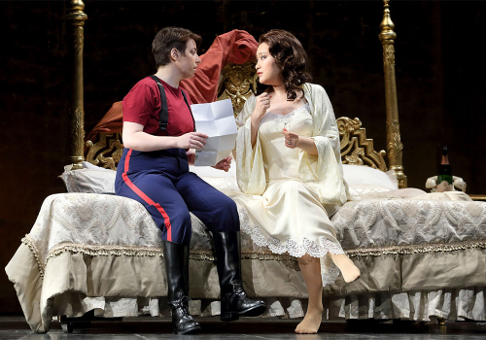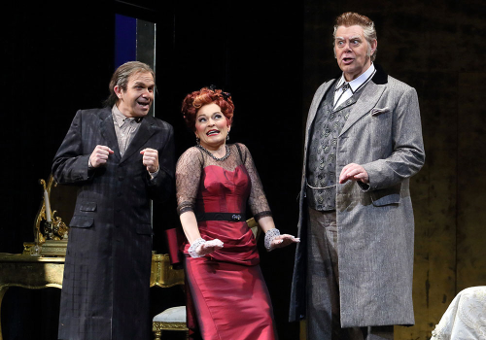Recently in Reviews
English Touring Opera are delighted to announce a season of lyric monodramas to tour nationally from October to December. The season features music for solo singer and piano by Argento, Britten, Tippett and Shostakovich with a bold and inventive approach to making opera during social distancing.
This tenth of ten Live from London concerts was in fact a recorded live performance from California. It was no less enjoyable for that, and it was also uplifting to learn that this wasn’t in fact the ‘last’ LfL event that we will be able to enjoy, courtesy of VOCES8 and their fellow vocal ensembles (more below …).
Ever since Wigmore Hall announced their superb series of autumn concerts, all streamed live and available free of charge, I’d been looking forward to this song recital by Ian Bostridge and Imogen Cooper.
The Sixteen continues its exploration of Henry Purcell’s Welcome Songs for Charles II. As with Robert King’s pioneering Purcell series begun over thirty years ago for Hyperion, Harry Christophers is recording two Welcome Songs per disc.
Although Stile Antico’s programme article for their Live from London recital introduced their selection from the many treasures of the English Renaissance in the context of the theological debates and upheavals of the Tudor and Elizabethan years, their performance was more evocative of private chamber music than of public liturgy.
In February this year, Albanian soprano Ermonela Jaho made a highly lauded debut recital at Wigmore Hall - a concert which both celebrated Opera Rara’s 50th anniversary and honoured the career of the Italian soprano Rosina Storchio (1872-1945), the star of verismo who created the title roles in Leoncavallo’s La bohème and Zazà, Mascagni’s Lodoletta and Puccini’s Madama Butterfly.
Evidently, face masks don’t stifle appreciative “Bravo!”s. And, reducing audience numbers doesn’t lower the volume of such acclamations. For, the audience at Wigmore Hall gave soprano Elizabeth Llewellyn and pianist Simon Lepper a greatly deserved warm reception and hearty response following this lunchtime recital of late-Romantic song.
Collapsology. Or, perhaps we should use the French word ‘Collapsologie’ because this is a transdisciplinary idea pretty much advocated by a series of French theorists - and apparently, mostly French theorists. It in essence focuses on the imminent collapse of modern society and all its layers - a series of escalating crises on a global scale: environmental, economic, geopolitical, governmental; the list is extensive.
For this week’s Live from London vocal recital we moved from the home of VOCES8, St Anne and St Agnes in the City of London, to Kings Place, where The Sixteen - who have been associate artists at the venue for some time - presented a programme of music and words bound together by the theme of ‘reflection’.
'Such is your divine Disposation that both you excellently understand, and royally entertaine the Exercise of Musicke.’
Amongst an avalanche of new Mahler recordings appearing at the moment (Das Lied von der Erde seems to be the most favoured, with three) this 1991 Mahler Second from the 2nd Kassel MahlerFest is one of the more interesting releases.
‘And there was war in heaven: Michael and his angels fought against the dragon; and the dragon fought and his angels, And prevailed not; neither was their place found any more in heaven … that old serpent … Satan, which deceiveth the whole world: he was cast out into the earth, and his angels were cast out with him.’
If there is one myth, it seems believed by some people today, that probably needs shattering it is that post-war recordings or performances of Wagner operas were always of exceptional quality. This 1949 Hamburg Tristan und Isolde is one of those recordings - though quite who is to blame for its many problems takes quite some unearthing.
There was never any doubt that the fifth of the twelve Met Stars Live in Concert broadcasts was going to be a palpably intense and vivid event, as well as a musically stunning and theatrically enervating experience.
‘Love’ was the theme for this Live from London performance by Apollo5. Given the complexity and diversity of that human emotion, and Apollo5’s reputation for versatility and diverse repertoire, ranging from Renaissance choral music to jazz, from contemporary classical works to popular song, it was no surprise that their programme spanned 500 years and several musical styles.
The Academy of St Martin in the Fields have titled their autumn series of eight concerts - which are taking place at 5pm and 7.30pm on two Saturdays each month at their home venue in Trafalgar Square, and being filmed for streaming the following Thursday - ‘re:connect’.
The London Symphony Orchestra opened their Autumn 2020 season with a homage to Oliver Knussen, who died at the age of 66 in July 2018. The programme traced a national musical lineage through the twentieth century, from Britten to Knussen, on to Mark-Anthony Turnage, and entwining the LSO and Rattle too.
With the Live from London digital vocal festival entering the second half of the series, the festival’s host, VOCES8, returned to their home at St Annes and St Agnes in the City of London to present a sequence of ‘Choral Dances’ - vocal music inspired by dance, embracing diverse genres from the Renaissance madrigal to swing jazz.
Just a few unison string wriggles from the opening of Mozart’s overture to Le nozze di Figaro are enough to make any opera-lover perch on the edge of their seat, in excited anticipation of the drama in music to come, so there could be no other curtain-raiser for this Gala Concert at the Royal Opera House, the latest instalment from ‘their House’ to ‘our houses’.
"Before the ending of the day, creator of all things, we pray that, with your accustomed mercy, you may watch over us."
Reviews
![Roberto Tagliavini as Figaro and Pretty Yende as Susanna [Photo: Craig T. Mathew / LA Opera]](http://www.operatoday.com/Figaro_002-Pb.png)
30 Mar 2015
The Marriage of Figaro, LA Opera
On March 26, 2015, Los Angeles Opera presented Mozart’s Le nozze di Figaro (The Marriage of Figaro). The Ian Judge production featured jewel-colored box sets by Tim Goodchild that threw the voices out into the hall. Only for the finale did the set open up on to a garden that filled the whole stage and at the very end featured actual fireworks.
Pierre-Augustin Caron de Beaumarchais wrote Le Mariage de Figaro (The Marriage of Figaro) as a sequel to his Le Barbier de Seville, (The Barber of Seville). In his preface to the play, the author notes that it was the Prince of Conti who requested him to continue the story. Figaro, who actually represents the author, advocates revolution much more avidly in the play than in the opera. The play’s Paris premiere on April 27, 1784 was an enormous success. It ran for sixty-eight consecutive performances, earning higher box-office receipts than any other eighteenth century French play. Sources say that the author donated his profit to charity. The first English production opened late that same year and ran into early 1785.
 Renee Rapier as Cherubino and Guanqun Yu as the Countess
Renee Rapier as Cherubino and Guanqun Yu as the Countess
Beaumarchais was a great deal more than just a playwright; he was also an arms dealer who was active in both the French and American Revolutions. Before 1778, when France officially entered the American war, the writer saw to the delivery of munitions, money and supplies to the colonists. The Central Intelligence Agency still has a file on him that was not declassified until 1993. It can be seen here.
On March 26, 2015, Los Angeles Opera presented Mozart’s Le nozze di Figaro (The Marriage of Figaro), the libretto of which writer Lorenzo da Ponte based on Beaumarchais’ Le Mariage de Figaro. The Ian Judge production featured jewel-colored box sets by Tim Goodchild that threw the voices out into the hall. Only for the finale did the set open up on to a garden that filled the whole stage and at the very end featured actual fireworks. The eclectic costume designs by Deidre Clancy did not set the action in any particular era.
Roberto Tagliavini was a magnificent Figaro who commanded the stage while out manouvering the Count. Tagliavini has a stentorian bass baritone voice with a robust delivery. He is a valuable asset to the company, as is Operalia winner Guanqun Yu who sang the Countess. She sang with radiant, creamy tones and impressive technical ability including an exquisite trill. As the Count, Ryan McKinny was a strict taskmaster who thought no underling should notice his foibles. He sang with dark, vigorous sounds. Pretty Yende was a piquant Susanna who paced herself well for this long role. She sang her last act aria with floods of lustrous tone. Renée Rapier’s Cherubino was a bubbly teenager who kept the action moving swiftly. His girlfriend, Barbarina, portrayed by So Young Park, sang her aria with radiant silvery tones. I understand she will sing the Queen of the Night next year.
 Robert Brubaker as Don Basilio, Lucy Schaufer as Marcellina and Kristinn Sigmundsson as Doctor Bartolo
Robert Brubaker as Don Basilio, Lucy Schaufer as Marcellina and Kristinn Sigmundsson as Doctor Bartolo
Bass Kristinn Sigmundsson was a lawyerly but lovable Dr. Bartolo who sang his patter with speed and accuracy. As Marcellina, who was once his lover, Lucy Schaufer was the embodiment of a difficult 1950s superdiva, and she sang at least as well. Joel Sorensen was a wonderfully amusing notary, Philip Cokorinos a convincing drunk, and Robert Brubaker a malicious Don Basilio. Chorus Director Grant Gershon’s singers sang with clear diction as they communicated Mozart’s subtle nuances.
One of the best reasons for attending opera in Los Angeles is the conducting of James Conlon. His Mozart is always magical and this performance was no exception. His tempi were fresh and his interpretation revealed sonorities that are occasionally missed. Los Angeles Opera brought us a fabulous cast and they sang one of the best renditions of The Marriage of Figaro that I have head in quite a few years.
Maria Nockin
Cast and production information:
Figaro, Roberto Tagliavini; Susanna, Pretty Yende; Count Almaviva, Ryan McKinny; Countess Almaviva, Guanqun Yu; Cherubino, Renée Rapier; Doctor Bartolo, Kristinn Sigmundsson; Marcellina, Lucy Schaufer; Don Basilio, Robert Brubaker; Don Curzio, Joel Sorensen; Barbarina, So Young Park; Antonio, Philip Cokorinos; Conductor, James Conlon; Director, Ian Judge; Scenery Designer, Tim Goodchild; Costume Designer, Deirdre Clancy; Lighting Designer, Mark Doubleday; Chorus Director, Grant Gershon; Original Choreographer, Sergio Trujillo; Choreographer, Chad Everett Allen.
![Roberto Tagliavini as Figaro and Pretty Yende as Susanna [Photo: Craig T. Mathew / LA Opera]](http://www.operatoday.com/Figaro_002-Pb.png)

